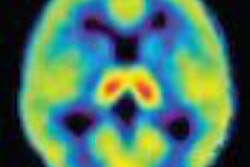A multisite study in Australia has found that PET results can change treatment plans for cancer patients, as the modality provides more information on the extent, recurrence, and progression of the disease.
PET was introduced to Australia in 1992 at two sites. For much of the decade, only limited government funding was available for the modality. By 2000, as more research data became available indicating PET's worth, the Australian government agreed to expand to eight facilities and provide interim funding. The one stipulation was that continued financial support would depend on positive results from what came to be known as the Australian PET Data Collection Project.
PET centers began to collect data on whether the modality changed the management of patients with different types of cancers and other applications, including melanoma, colorectral carcinoma, ovarian cancer, brain tumors, epilepsy, and myocardial viability.
Ovarian cancer
A three-site study on ovarian cancer recruited 90 women, with a mean age of 60 years, ranging from 35 to 85 years, from 2003 to 2006. All the women had a previous history of treated epithelial ovarian carcinoma and suspected recurrence, based on elevated CA-125 levels, anatomical imaging, or clinical symptoms.
The women also had to be at least 18 years old, willing to undergo proposed treatment -- whether it be surgery or chemotherapy -- and available for a 12-month follow-up.
"All patients had a conventional workup prior to PET, which included CT, ultrasound, CA-125, and a physical exam," said Michael Fulham, a professor of molecular imaging and nuclear medicine at Royal Prince Alfred Hospital in Camperdown, New South Wales.
Fulham and Dr. Andrew Scott from the Centre for PET at Austin Hospital in Melbourne, Victoria, presented results of the Australian PET Data Collection Project at the 2007 SNM meeting in Washington, DC.
All the patients also had PET/CT scans. While the dose of FDG varied among the three sites, the uptake period was standard.
After the scan, referring physicians were asked to specify their pre-PET management plan for the patients; note if management was altered after PET/CT; and rate to what degree the PET scan changed patient management. There were four change categories: None -- the PET information was ignored, low -- treatment modality was unchanged, medium -- planned procedure/dose or mode of therapy was altered, and high -- treatment modality changed.
Pre-PET management could include radiotherapy, chemotherapy, surgery, and other measures, such as observation. Patients were followed for six to 12 months post-PET/CT scan for their clinical status, evidence of recurrence, and any disease progression.
Disease detection
"In pre-PET evaluation, there were 137 lesions identified by CT. Then, PET/CT found at least 160 additional sites of disease not identified by conventional imaging in 61 patients," Fulham said. "I say 'at least,' because you just couldn't count all the sites of disease. The bulk of them were below the diaphragm where there were multiple nodule sites; we just grouped them into one site."
The study found that PET changed management in 59% of patients, with the majority of the cases rated as high impact by physicians. Approximately 49% had a change in modality treatment.
Fulham noted some limitations of the ovarian cancer study. Researchers were unable to confirm all the sites of abnormal FDG uptake, either through biopsy, serial anatomical imaging, or repeat PET/CT imaging. Fulham cited "ethical issues in doing multiple biopsies in these patients." Also, the study could not conduct more than one PET/CT scan under the current Australian Medicare regulations, so it was "just a one-shot deal for the study," he added.
Based on the results, PET/CT was "clearly superior to abdominal and pelvic CT in the detection of modal, peritoneal, and subcapsular liver disease," Fulham said.
Metastatic melanoma
In the project study on the management of patients with suspected or proven metastatic melanoma prior to surgery, 134 patients (90 men, 44 women) were recruited between 2001 and 2006, with a mean age of 57 years, ranging from 19 to 88 years. The patients had a previous history of melanoma or metastatic melanoma, and were being considered for major surgical intervention.
FDG PET/CT was performed on 114 patients, while only PET imaging was conducted on 20 patients. The dose of FDG varied among the three sites, with uptake period a standard 60 minutes. Pre-PET patient management was generally surgery, but included radiotherapy and chemotherapy. Patients also received follow-up evaluations at three-, six-, nine-, and 12-month marks for post-PET and clinical status to determine the recurrence and progression of disease.
The results found that PET detected 373 lesions, 189 of which were additional lesions in 74 patients, not seen on other modalities. Management was changed in 62% of patients, and the pre-PET surgical plan was reduced by 33%. The management impact was rated as high in 42% and medium in 19% of the cases.
In addition, patients with additional glucose-avid lesions were more likely to have progressive disease within 12 months of an initial PET scan.
According to Fulham, the results also offer the opportunity for PET/CT to replace other technology in certain applications. "I'd like to see patients -- rather than get a CT of the chest, abdomen, or pelvis -- preferably get an MR and then PET/CT," he said. "You replace the additional radiation exposure from a conventional or diagnostic CT with a PET/CT.
"In addition, we looked at patients with multiple sites of disease in terms of progression," he continued. "I am stating the obvious, but those patients with additional lesions progressed more rapidly in the next 12 months. PET was able to identify those patients and that was significant."
As for study limitations, Fulham noted the potential bias of referring doctors who knew the data was being used for the project. The physicians already had extensive experience with PET in their institutions and knew of the modality's value. "You can't leave out the fact that they knew a positive outcome would affect the willingness of the government to continue to fund PET," Fulham said.
Colorectal cancer
With colorectal cancer, the project also sought to expand upon the "paucity of multicenter prospective studies in the literature assessing true management impact in this population," Scott said in his SNM presentation.
The four-site study divided 191 patients with a mean age of 66 years into two groups. Group A consisted of symptomatic patients with a residual structural lesion suspicious for recurrent tumor after initial therapy, and group B was made up of patients with pulmonary or hepatic metastases, which were potentially resectable as determined by conventional imaging.
Patients were required to have colorectal carcinoma and were followed for 12 months to determine actual management and assess clinical outcomes. The study excluded patients who had received chemotherapy within one week, had undergone surgery in the previous six weeks, had uncontrolled diabetes, were pregnant, or unable to provide informed consent.
Sixty-six percent of group A patients had management plans altered based on the PET results, while 49% of group B patients had their treatment changed due to PET.
Prior to the PET scan, 25 patients were slated for surgery in the pre-PET plan. That number decreased to 14 after the PET scan. In addition, the number of patients scheduled for chemotherapy declined from 18 to three patients.
PET also detected additional disease sites in 48% of group A and 44% of group B. In group A, a progressive disease was identified in 60% of patients with additional lesions detected by PET, compared with conventional imaging, while 36% of patients in group A had no additional lesions detected by PET. In group B, progressive disease was identified in 66% of patients with additional lesions and 39% of patients had no additional lesions detected by PET.
In patients who had isolated lung or hepatic disease, the researchers stratified them according to whether they had localized or disseminated disease, as well as whether they had liver-only versus more diffuse (disease) or lung-only or more disseminated disease, and found "highly significant stratification based on 12-month follow-up, indicating that PET is not only able to accurately identify extended disease, but also be very powerful in predicting prognosis in this population," Scott said.
Other applications
Scott also presented the results of the project's study on the impact of FDG PET in oncology, epilepsy, and cardiac patients to assess myocardial viability.
Data from 30,368 PET scans (29,585 oncology, 688 epilepsy, and 95 cardiac) were collected from March 2003 to April 2005. The mean age of patients was 58 years, ranging from one to 99 years, with 58% of the patients being male.
The results show that the main indications for oncology were diagnosis (14% of total studies), staging (34%), and restaging (49%). In staging and restaging studies across all tumor types, between 19% and 45% of patients were upstaged or downstaged based on PET. In addition, 25% of patients with equivocal investigations pre-PET could be restaged by PET.
In patients with temporal and extratemporal lobe epilepsy on the basis of standard investigations, PET localized epileptogenic foci in 70% and 43% of the patients, respectively.
In addition, PET identified 30% more myocardial segments as viable, compared with conventional imaging.
By Wayne Forrest
AuntMinnie.com staff writer
July 19, 2007
Related Reading
PET scans useful in identifying colorectal cancer recurrence, July 9, 2007
PET/CT, whole-body MRI each have merits in metastatic breast disease, May 29, 2007
PET plays universal role in pre- and post-treatment for head and neck cancer, April 26, 2007
Dual-phase PET/CT useful in lung nodule assessment, April 4, 2007
CT and PET screening useful in detecting early lung cancer, June 15, 2005
Copyright © 2007 AuntMinnie.com



















